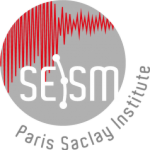Le prochain séminaire de l’Institut SEISM aura lieu au CEA Saclay le 19 mai 2015 à 14h30 et sera suivi d’une discussion autour d’un café.
Loïc Viens, actuellement en thèse à l’Earthquake Research Institute de Tokyo, sous la direction de Kazuki KOKETSU et d’Hiroe MIYAKE, nous présentera ses travaux sur la « Prédiction du mouvement sismique en zone de subduction en utilisant le bruit de fond : focus sur les fosses de Nankai et Sagami au Japon. »
Abstract
The ever-increasing construction of large-scale structures such as high-rise buildings, oil tanks, and suspension bridges requires an accurate prediction of long-period ground motions (≥ 4 s) to assess the seismic hazard. It has been shown in previous studies that surface-to-surface impulse response functions canbe extracted from the ambient seismic field recorded by two stations and used to predict the long-period ground motions generated by moderate crustal earthquakes in California and Japan. In this study, we first focus on the northern part of the Nankai trough where two submarine cables have been deployed by the Japan Meteorological Agency (JMA). We extracted the impulse response functions between OBSs (virtual sources) and on-land stations (receivers) and show that these offshore-onshore impulse response functions predict accurately the ground motions of moderate subduction earthquakes. Then, we focus on the Sagami trough which is located close to the Tokyo city. We extracted the impulse response functions between stations located atop the 1923 Kanto earthquake fault plane (virtual sources) and the Hi-net and MeSO-net stations located in the Kanto basin (receivers). We confirm that impulse response functions are in good agreement with the waveforms of shallow Mw ~5 earthquakes that occurred close to the virtual sources in a period range of 4 to 10 s. Finally, we extend this point source method, suitable for moderate events, to finite rupture scenarios to simulate the ground motions that could be generated by large magnitude earthquakes (Mw 6-8).
